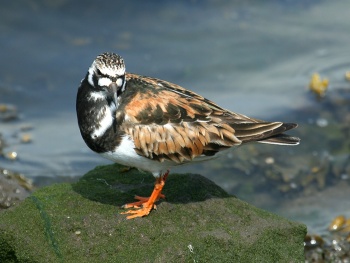(behav) |
(Imp sizes. Basic tidy-up. References updated) |
||
| Line 2: | Line 2: | ||
;[[:Category:Arenaria|Arenaria]] interpres | ;[[:Category:Arenaria|Arenaria]] interpres | ||
==Identification== | ==Identification== | ||
| − | + | 21–26 cm (8¼-10¼ in)<br/> | |
Ws. 52cm<br/> | Ws. 52cm<br/> | ||
Wt. 120gm<br/> | Wt. 120gm<br/> | ||
| Line 12: | Line 12: | ||
*Dark brown back and head | *Dark brown back and head | ||
**Reddish brown upperparts during breeding | **Reddish brown upperparts during breeding | ||
| − | + | [[Image:Turnstone64.jpg|thumb|350px|right|Breeding plumage <br />Photo by {{user|AndyMc|AndyMc}}<br />Long Drag, Seal Sands, May 2008]] | |
| − | + | The summer breeding plumage of breeding (from which it gets its name) is rarely observed as they migrate to areas that have a very low human presence. | |
| − | [[Image:Turnstone64.jpg|thumb|350px|right|Photo by {{user|AndyMc|AndyMc}}<br /> | ||
==Distribution== | ==Distribution== | ||
A widely distributed species along shorelines of continents. Breeds on tundra in the extreme northern latitudes of [[North America]], [[Europe]], and [[Russia]].<br/> | A widely distributed species along shorelines of continents. Breeds on tundra in the extreme northern latitudes of [[North America]], [[Europe]], and [[Russia]].<br/> | ||
| Line 21: | Line 20: | ||
==Taxonomy== | ==Taxonomy== | ||
Formerly considered a plover, it is now classified in the sandpiper family. | Formerly considered a plover, it is now classified in the sandpiper family. | ||
| + | ====Subspecies==== | ||
| + | [[Image:Mart5Nov08 025 copy.jpg|thumb|350px|right|Photo by {{user|sandmartin|sandmartin}}<br />Rhyl, North [[Wales]], January 2009]] | ||
| + | There are 2 subspecies<sup>[[#References|[1]]]</sup>: | ||
| + | *''A. i. interpres'': | ||
| + | :*[[Alaska]], northern [[North America]] and northern [[Eurasia]], winters to [[Africa]] and [[Australasia]] | ||
| + | *''A. i. morinella'': | ||
| + | :*North-eastern Alaska and Arctic [[Canada]]; winters south-eastern [[US]] to southern [[South America]] | ||
==Habitat== | ==Habitat== | ||
| − | Rocky Shores. | + | Rocky Shores. Marshy lowland slopes, and tundra. Casual inland. |
==Behaviour== | ==Behaviour== | ||
| − | |||
Fairly long-lived, with an average around 9 years and a recorded record of 19. | Fairly long-lived, with an average around 9 years and a recorded record of 19. | ||
| Line 31: | Line 36: | ||
The action of flipping over small stones to find food led to its common name. It will take just about anything organic, including insects, carrion, mollusks, eggs, worms, etc. | The action of flipping over small stones to find food led to its common name. It will take just about anything organic, including insects, carrion, mollusks, eggs, worms, etc. | ||
====Breeding==== | ====Breeding==== | ||
| − | Monogomous. Individual birds often return to favorite spots year after year. | + | [[Dictionary_M-O#M|Monogomous]]. Individual birds often return to favorite spots year after year. |
===Vocalisation=== | ===Vocalisation=== | ||
A long rapid trill. | A long rapid trill. | ||
| Line 37: | Line 42: | ||
''[[Media:Arenaria interpres (song).mp3|Listen in an external program]]'' | ''[[Media:Arenaria interpres (song).mp3|Listen in an external program]]'' | ||
==References== | ==References== | ||
| − | #Collins Field Guide 5th Edition#[http://birdforum.net/showthread.php?t=177353 Birdforum thread] with link to migration study | + | #{{Ref-Clements6thAug15}}#Handbook of the Birds of the World Alive (retrieved February 2016) |
| + | #Collins Field Guide 5th Edition | ||
| + | #[http://birdforum.net/showthread.php?t=177353 Birdforum thread] with link to migration study | ||
| + | {{ref}} | ||
==External Links== | ==External Links== | ||
| − | {{GSearch|Arenaria+interpres}}<br /> | + | {{GSearch|Arenaria+interpres}} |
| + | <br /> | ||
{{Video|Ruddy_Turnstone}} | {{Video|Ruddy_Turnstone}} | ||
Revision as of 23:45, 15 February 2016
- Arenaria interpres
Identification
21–26 cm (8¼-10¼ in)
Ws. 52cm
Wt. 120gm
- Relatively small and stocky
- Short orange legs
- Short, sharp black bill
- Dark bib (black during breeding, April-September)
- White underparts
- Dark brown back and head
- Reddish brown upperparts during breeding
The summer breeding plumage of breeding (from which it gets its name) is rarely observed as they migrate to areas that have a very low human presence.
Distribution
A widely distributed species along shorelines of continents. Breeds on tundra in the extreme northern latitudes of North America, Europe, and Russia.
Overwintering range almost worldwide. Fairly common on the shores of the Great Lakes of North America during migration.
Taxonomy
Formerly considered a plover, it is now classified in the sandpiper family.
Subspecies
There are 2 subspecies[1]:
- A. i. interpres:
- Alaska, northern North America and northern Eurasia, winters to Africa and Australasia
- A. i. morinella:
- North-eastern Alaska and Arctic Canada; winters south-eastern US to southern South America
Habitat
Rocky Shores. Marshy lowland slopes, and tundra. Casual inland.
Behaviour
Fairly long-lived, with an average around 9 years and a recorded record of 19.
A strong flier that during migration is able to fly from southern Australia to Taiwan in one stretch.
Diet
The action of flipping over small stones to find food led to its common name. It will take just about anything organic, including insects, carrion, mollusks, eggs, worms, etc.
Breeding
Monogomous. Individual birds often return to favorite spots year after year.
Vocalisation
A long rapid trill.
<flashmp3>Arenaria interpres (song).mp3</flashmp3>
Listen in an external program
References
- Clements, J. F., T. S. Schulenberg, M. J. Iliff, D. Roberson, T. A. Fredericks, B. L. Sullivan, and C. L. Wood. 2015. The eBird/Clements checklist of birds of the world: v2015, with updates to August 2015. Downloaded from http://www.birds.cornell.edu/clementschecklist/download/
- Handbook of the Birds of the World Alive (retrieved February 2016)
- Collins Field Guide 5th Edition
- Birdforum thread with link to migration study
Recommended Citation
- BirdForum Opus contributors. (2024) Ruddy Turnstone. In: BirdForum, the forum for wild birds and birding. Retrieved 27 April 2024 from https://www.birdforum.net/opus/Ruddy_Turnstone
External Links






